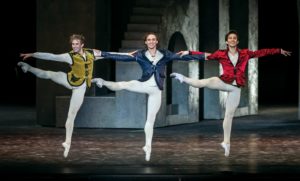Verona: Winter 2019 - Vancouver Ballet Society
- Home
- City Reports 2015 - 2019
- Verona: Winter 2019

By Silvia Poletti
Established dance festivals all around the country made the last few months a rich and lively time. A wide range of current choreographic trends was key to larger festivals such as Bolzano Danza, while others balanced their programs between first class contemporary dance and ballet companies on tour. Italians were lucky enough to see Batsheva — The Young Ensemble at Florence Dance Festival; Hamburg Ballet at Ravenna Festival; Dutch National Ballet’s tribute to Hans Van Manen at Two Worlds Festival in Spoleto; and a wonderful homage to Merce Cunningham by the Centre national de danse contemporaine — Angers at Bolzano Danza.
The most exciting event was the world premiere of Romeo and Juliet by Danish choreographer (and former principal dancer with the Royal Danish Ballet and London’s Royal Ballet) Johan Kobborg. There were many reasons for this: first, the venue — the Arena in Verona, the greatest ancient open-air theatre, which typically attracts thousands of spectators. Then, the performers, led by superstars Alina Cojocaru and Sergei Polunin. And, above all, the production itself, which was supported by Polunin through Polunin Ink, an independent platform the dancer founded for new ballet projects that should be both popular in the sense of being able to reach the largest audience possible and have a creative approach that evolves the classical vocabulary.
How did Kobborg’s Romeo and Juliet work? Rather well, indeed.
Kobborg cut almost a third of the original Prokofiev score (including the bedroom pas de deux) to give his storytelling a quicker pace that emphasized the breathless speed of the actions and emotions. His focus is on the sudden explosion of passion — love, but also rage and despair, which are accentuated: Capulet violently slaps Juliet’s face in front of the people of Verona to remind her she must obey him; after Tybalt’s death, a desperate Juliet rushes and jumps against Romeo’s chest, crying; the duels, especially between Tybalt and Romeo, are spectacular and realistic in their blind outbursts. Kobborg amplifies these impressions by using a continuous stream of larger-than-life movement: big jumps and wide turns, long glissades, high lifts à la Russe, dazzling fish dives — all executed at great speed, à la Balanchine. In this way, he works to exalt the technical qualities of his dancers and their characters more than to invent an original choreographic language.
A leading soloist of the British Royal Ballet, Valentino Zucchetti, as Mercutio, was revealed as a brilliant actor whose physical gestures blend pantomime with the whirling dynamics of his jumps and turns. Atlanta Ballet’s Nikolas Gaifullin — a true revelation — was an impetuous and virtuosic Prince of Cats, as Tybalt is described in the play.
As for the leads, Romeo and Juliet are introduced by two solos at the very beginning, giving us danced portraits of their personalities. Polunin’s Romeo flies and devours the stage with his stealthy jumps; his youthful exuberance dominates air and ground, as when he falls to the stage floor after a breathless dance that expresses his wish to catch every moment of life. Cojocaru’s Juliet is lively and curious about the life she does not yet know. Her quick footwork with continuous changes of direction seems to suggest her wish to explore new paths.
In the first scenes of the ballet Juliet always appears at the top of the beautiful set conceived by sculptor David Umemoto. Indeed, the set, which features a stony-looking sculpture in dark grey with revealing arches, terraces and staircases, is almost another principal character. In its folds the two lovers play hide and seek at their first encounter; up on the high terrace Lord Capulet (Ross Freddie Ray) expresses his will that Juliet marry Paris (Kilian Smith); the desperate rush of the lovers after Tybalt’s death ends abruptly against the sculpture’s back wall, a symbolic, traumatic stop to their hopes of freedom.
The elegant and stylized costumes, revisiting the Renaissance through a contemporary eye, were by fashion group Collettivo Anonimi Creativi.
In the well-defined character role of Romeo, Polunin shows his magnetic stage personality and the quality of his dance, which is sparkling, rich with nuance and appearing incredibly natural although full of ballet virtuosity. In close relationship to Cojocaru, one of the greatest dancing actresses of the present day — her powerful and expanded gestures of despair recall the acting skills of the celebrated Carla Fracci, the very first Juliet in John Cranko’s version of the ballet — Polunin balances his tenderness and impetuosity well. No wonder this Romeo and Juliet thrilled more than 10,000 spectators, who came from all over the world to attend the one-night only performance.

Photo: Luca Vantusso
